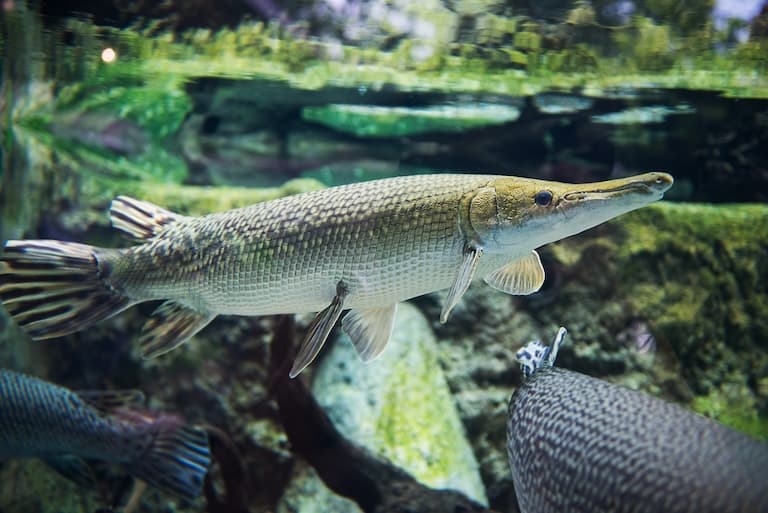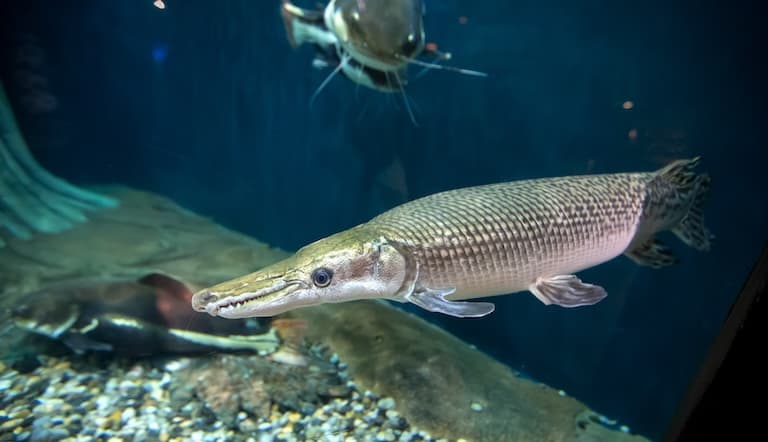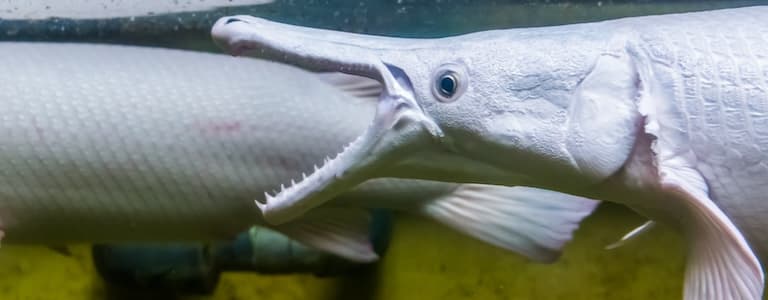Alligator Gar
In the Gulf of Mexico swims one of North America’s largest and most ancient aquatic predators. This is an animal that retains features of fish that existed long before the earliest crocodilians evolved, so while it’s called an alligator gar, it would be more accurate to call the common alligator a gar crocodile.
Regardless, this giant predator is a terrifying reminder of what the world of freshwater once looked like.

Alligator Gar Facts Overview
| Habitat: | Wetlands, marine, coastal |
| Location: | Rivers and coasts around the Gulf of Mexico |
| Lifespan: | Up to 50 years |
| Size: | Up to 3m (10 ft) long |
| Weight: | Up to 159 kg (350 lb) |
| Colour: | Brown or olive green, lighter on the belly |
| Diet: | Mostly smaller fish, also crabs, turtles, birds, and small mammals |
| Predators: | Larger fish, actual alligators |
| Top Speed: | Unknown |
| No. of Species: | 1 |
| Conservation Status: | Least Concern (IUCN) |
This fish can grow to truly enormous proportions – longer than the average length of an American Alligator – and has a face that adds significantly to its intimidating presence.
It’s one of a handful of freshwater giants found in North American waters, and a member of a dying breed: ancient aquatic predators, relatively unchanged in tens, if not hundreds of millions of years.
With this comes a series of adaptations not usually found in the ray-finned fish lineage at all. But also, a destrictive sense of fear and glory among those who want to catch and kill such an incredible beast.
Interesting Alligator Gar Facts
1. They’re Ginglimodians
This is a clade that sounds like it came straight out of Rick and Morty, and is almost as fantastical.
This group of ray-finned fish was once widespread and prevalent. It makes up the other branch of the infraclass that contains the bowfins and originates from some time before 2400 million years ago, during the Triassic period – roughly the time Dinosaurs were entering the mainstream.
This lineage diversified greatly throughout the two subsequent dinosaur resurgences, starting their existence in marine environments and then evolving to take on freshwater too, but by the mid-Cretaceous, the Ginglymodians experienced a rapid drop-off, leaving only the gars to represent what was once a major player in aquatic ecosystems worldwide.
Gars at this time were found on every continent except Antarctica and Australia, but now only seven species remain, all limited to the freshwater systems of the Americas.
The Alligator gar is the largest, and like the others, carries with it some adaptations that have been lost in the remaining ray-finned fish lineages. 1
2. They are ancient
One of the reasons gars are considered living fossils is their slow rate of evolution. Among all the jawed vertebrates, the gar’s molecular evolution is the most sluggish known, slowing not only the rate of morphological change in their line but also the rate of speciation as a whole.
This concept of evolutionary stasis is something that isn’t well understood, but it means that the alligator gar looks a hell of a lot like it did 50 million years ago, and possibly as far back as 100 million years ago, with two species related that far back showing that they are still able to produce fertile hybrid offspring.
To put this in perspective, as much as you might try (and you shouldn’t), you would never be able to impregnate or be impregnated by, our closest evolutionary relative: the chimpanzee.
Estimates put our common ancestor between about 5 and 13 million years ago, and this has been more than enough time for our genes to drift apart to the point where we can’t produce hybrids at all, fertile or otherwise.
Generally, the closer related two organisms are, the more viable their reproduction becomes (up to a point – you can be too closely related). Lions and tigers can reproduce, having been separated by about 4 or 5 million years, but their offspring are sterile because the genes no longer match closely enough.
Polar and grizzly bears are separated by only 20,000 to 50,000 years and their genes are still a close enough match for their abominable spawn to emerge fertile, furious, and ready to take over the world.
All of this goes to show that for two species to be able to breed after as much as 100,000,000 years of separation means their genes have mutated at a remarkably slow pace compared with many other animal examples. In fact, it’s the oldest compatible relationship between any Eukaryote!
And this is why the alligator gar retains a lot of features lost in other fish of its kind.
3. They have primitive features
This slow rate of change means that they still contain weird quirks of fishy biology that have since been lost to time.
One such quirk is the spiral gut, seen commonly in sharks, but lost in the vast majority of bony fishes. Interestingly, other primitive giants such as the freshwater sturgeon also differ from the Teleost fishes in retaining this characteristic.
But wait! There’s more. 2

4. Their scales are weird
Even the scales on the body of the alligator gar are unusual. They’re known as ganoid scales, which are named after the structural salt that makes them, Ganoine. This is essentially the same molecule as the enamel found in teeth.
Ganoid scales are incredibly armoured, with serrated edges and almost impenetrable by the teeth of potential predators. These are scales that evolved during a very dangerous time for fish and persist even in the absence of a lot of the prehistoric predators that would have shared the water with the gars.
Ancient lobe-finned fishes like the Coelacanth and lungfishes have what are known as Cosmoid scales, and these are almost more like teeth than scales.
It’s thought that the Ganoid scales derived from these ancient structures, and now only the non-teleost fishes have them. 3
5. Their teeth are weird too
Unlike other gar species, the upper jaw of an alligator gar has a dual row of large, sharp teeth which set it apart. The inner row is larger than the outer row, and flatter, but slender and fang-like, which shows that this is primarily a fish-eating species. 4

6. They can breathe air
Curiously, like other large freshwater fishes, the alligator gar has evolved to compensate with low-oxygen water by evolving to breathe air.
Some suggest that this species gets up to 70% of its oxygen from the air, and is often seen coming up for a gulp.
Inside, is a vascular bladder that allows the transfer of oxygen from the air to the body of the fish, very similar to the way a lung works, and this lets the gar live in slow-moving, hotter freshwater where other species would suffocate. 5
Alligator Gar Fact-File Summary
Scientific Classification
| Kingdom: | Animalia |
| Phylum: | Chordata |
| Class: | Actinopterygii |
| Order: | Lepisosteiformes |
| Family: | Leisosteidae |
| Genus: | Atractosteus |
| Species: | Spatula |
Fact Sources & References
- Chase D Brownstein (2024), “The genomic signatures of evolutionary stasis ”, Oxford Academic.
- Thodoris Argyriou (2016), “Exceptional preservation reveals gastrointestinal anatomy and evolution in early actinopterygian fishes”, NIH.
- Wen Yang (2012), “Structure and fracture resistance of alligator gar (Atractosteus spatula) armored fish scales”, Science Direct.
- “Alligator Gar”, Florida Museum.
- Stefan Lovgren (2023), “All Hail the Alligator Gar, a Giant and Primordial River Monster”, Texas Monthly.
